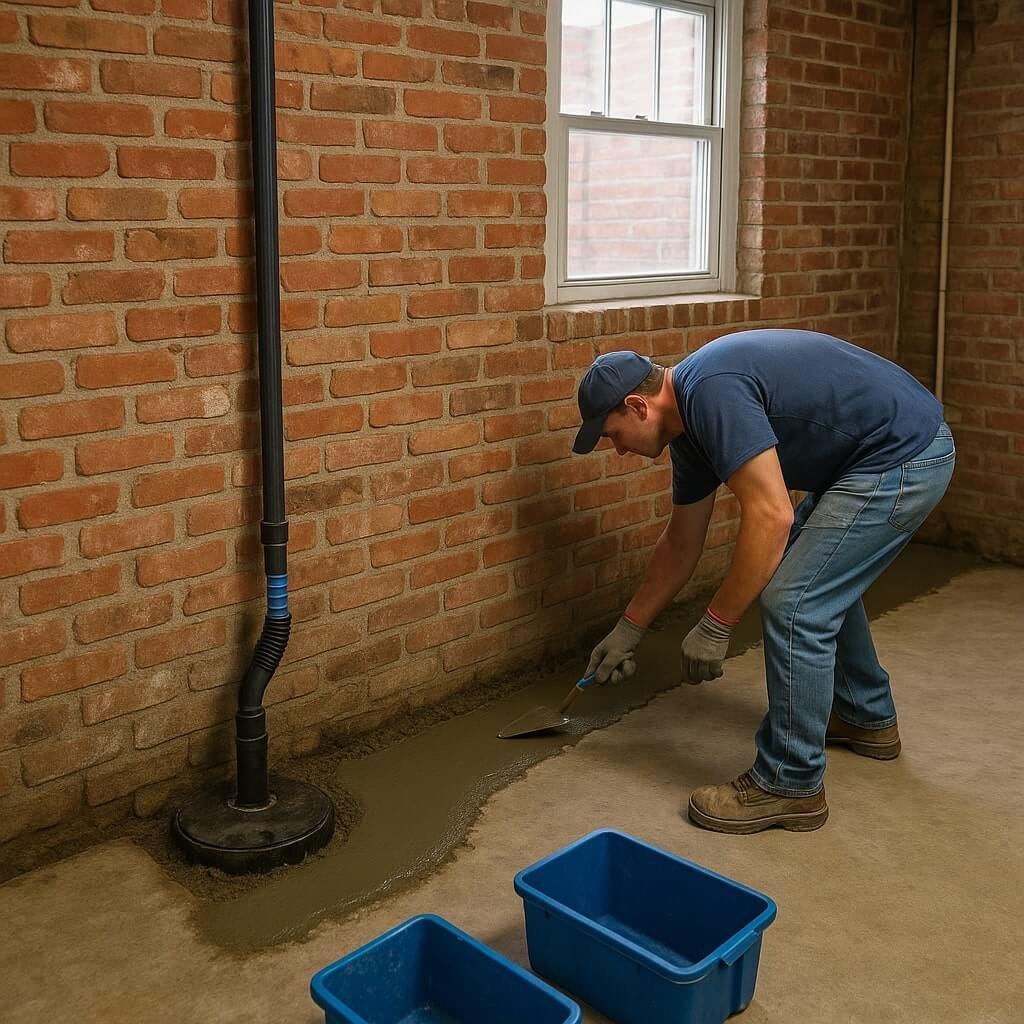Waterproofing your basement in Hutchinson is vital for preventing moisture-related issues that can compromise your home’s integrity. Start by identifying common causes of water problems and evaluating your basement for signs of leaks or humidity. Understanding the right waterproofing methods and materials is essential. As you proceed, you’ll discover effective strategies that can safeguard your space, but knowing when to tackle the job yourself versus calling in professionals is equally important.
Key Takeaways
- Begin by assessing your basement for signs of water damage, such as stains, leaks, and moisture levels using a moisture meter.
- Improve exterior drainage by ensuring proper grading and cleaning gutters to direct water away from your foundation.
- Choose appropriate waterproofing methods, like sealants for walls or drainage tiles for exterior solutions, based on the type of water intrusion.
- Perform regular inspections and maintenance of your waterproofing systems, monitoring humidity levels and testing sump pumps monthly.
- Consider hiring professionals for complex repairs to ensure effective solutions and minimize risks associated with severe water issues.
Understanding the Importance of Basement Waterproofing
When you consider the long-term integrity of your home, understanding the importance of basement waterproofing can’t be overstated.
Effective moisture control is essential in mitigating basement humidity, which can lead to structural damage and mold growth. Implementing waterproofing measures helps create a barrier against water intrusion, ensuring that your basement remains dry and functional.
Effective moisture control prevents structural damage and mold growth, keeping your basement dry and functional.
By addressing potential leaks and sealing cracks, you markedly reduce the risk of moisture accumulation. Regular assessments and maintenance of your waterproofing system further enhance its effectiveness.
Ultimately, prioritizing basement waterproofing safeguards your home’s value and contributes to a healthier living environment for you and your family.
Common Causes of Basement Water Problems
Understanding the common causes of basement water problems is essential for effective prevention and remediation. Many issues arise from inadequate exterior drainage and foundation cracks. Here’s a breakdown of these factors:
| Cause | Description |
|---|---|
| Poor Exterior Drainage | Water accumulation near the foundation leads to seepage. |
| Foundation Cracks | Structural weaknesses allow water ingress. |
| Soil Saturation | Excessive moisture can overwhelm drainage systems. |
Addressing these issues promptly helps maintain a dry basement. Regular inspections and proactive measures will mitigate potential water damage, ensuring your space remains safe and functional.
Assessing Your Basement for Water Issues

How can you effectively assess your basement for water issues? Start by inspecting the walls and floor for visible signs of water damage, such as stains or discoloration.
Next, check for identifying leaks around windows, pipes, and joints. Use a moisture meter to pinpoint hidden moisture sources, especially in corners and behind appliances.
Inspect for leaks around windows and pipes, and utilize a moisture meter to uncover hidden dampness in corners and behind appliances.
Additionally, examine the exterior grading and gutters to guarantee water drains away from your foundation. Pay attention to musty odors, as they often indicate dampness.
Document any findings, as this will help you address the issues with targeted solutions later on.
Choosing the Right Waterproofing Method
Choosing the right waterproofing method for your basement involves evaluating several factors, including the type of water intrusion and the specific characteristics of your space.
For instance, if water seeps through walls, consider interior waterproofing techniques like sealants or drainage systems. If groundwater pressure is significant, you might need exterior waterproofing solutions, including drainage tiles and waterproof membranes.
Assess your environment, as soil type and drainage patterns affect your choice. Prioritize methods that suit your basement’s conditions to effectively prevent water damage and maintain structural integrity.
Making an informed decision now can save you from costly repairs later.
Essential Materials for Waterproofing
Selecting the right materials is essential for effective basement waterproofing.
You’ll need to gather appropriate waterproofing materials and important tools before starting your project.
Here’s a concise list to help you prepare:
- Waterproofing Membrane: A vital barrier against moisture.
- Sealant: For filling cracks and gaps in walls and floors.
- Drainage System: To divert water away from the foundation.
- Sump Pump: An important tool for removing accumulated water.
Step-by-Step Waterproofing Process
To effectively waterproof your basement, you need to start by evaluating any water damage present.
Once you’ve identified problem areas, sealing cracks and gaps is essential to prevent further moisture intrusion.
Finally, installing a proper drainage system will help manage water flow and protect your basement from future issues.
Assessing Water Damage
How can you effectively assess water damage in your basement? Start with a thorough water damage assessment using these moisture detection techniques:
- Visual Inspection: Look for discoloration, mold, or peeling paint on walls and floors.
- Moisture Meter: Use a moisture meter to pinpoint damp areas in walls or floors.
- Humidity Levels: Check relative humidity levels; anything over 60% can signal a problem.
- Smell: Pay attention to musty odors, which often indicate trapped moisture.
Sealing Cracks and Gaps
As you begin sealing cracks and gaps in your basement, understanding the types of materials and methods available is essential for effective waterproofing.
Start with crack sealing compounds specifically designed for concrete; these can be polyurethane or epoxy-based. Clean the area thoroughly, removing any debris or loose material. Apply the sealant according to the manufacturer’s instructions, guaranteeing it fills the crack entirely.
For gap filling, use a high-quality foam or caulk to seal larger openings around pipes or walls. Smooth the surface for a tight seal. Allow adequate curing time before testing for leaks to guarantee a waterproof barrier.
Installing Drainage Systems
While sealing cracks and gaps is essential, installing an effective drainage system is equally important for preventing water accumulation in your basement.
Follow these steps for proper installation:
- Assess drainage system types: Choose between interior and exterior systems based on your needs.
- Excavate the area: Dig a trench around your basement perimeter, ensuring it’s deep enough for drainage pipes.
- Install drainage pipes: Position perforated pipes at the trench base, directing water towards the sump pump.
- Sump pump installation: Place the sump pump in a designated pit to efficiently remove collected water.
This method effectively protects your basement from water damage.
Maintenance Tips to Keep Your Basement Dry
To guarantee your basement remains dry, regular maintenance is essential in preventing water intrusion and damage.
Start with regular inspections of your waterproofing systems; check for cracks, leaks, and signs of mold. Monitor basement humidity levels using a hygrometer, aiming to keep it below 60%.
Make sure gutters direct water away from your foundation, and regularly clean them to avoid overflow. Inspect sump pumps monthly, testing functionality and clearing debris.
Additionally, seal any gaps or cracks in walls and floors with a high-quality sealant to further reduce moisture entry.
Consistent attention to these tasks will help maintain a dry basement environment.
When to Call in the Professionals

If you notice signs of serious damage, such as significant water intrusion or structural cracks, it’s time to call in the professionals.
Complex repair techniques often require specialized skills and equipment that go beyond DIY solutions.
Additionally, consider the time and cost implications; professional help can save you from further damage and expense down the line.
Signs of Serious Damage
Basement waterproofing is essential for maintaining your home’s structural integrity, and recognizing signs of serious damage can save you from costly repairs down the line.
Look out for these warning signals:
- Visible cracks in the foundation indicate potential structural issues.
- Persistent basement leaks after rainfall, suggesting inadequate waterproofing.
- Mold or mildew growth can lead to health hazards and further decay.
- Bowing walls or uneven floors signal severe foundation issues.
If you notice any of these signs, it’s time to call in professionals to assess and address the damage effectively.
Complex Repair Techniques
While some basement issues can be handled with DIY solutions, complex repair techniques often require professional expertise to guarantee safety and effectiveness.
If you’re facing significant water intrusion, structural damage, or foundation cracks, it’s time to call in the experts.
Advanced techniques, such as underpinning or epoxy injection, are vital for stabilizing and reinforcing compromised structures.
Professionals use specialized equipment and repair methods tailored to your specific situation, ensuring a long-lasting fix.
Relying on their knowledge and experience minimizes risks and maximizes the integrity of your basement, which is essential for preventing future issues and maintaining your home’s value.
Time and Cost Considerations
Understanding the time and cost considerations associated with basement waterproofing is essential for making informed decisions about when to engage professionals.
Here are key factors to evaluate:
- Budget Considerations: Determine your financial limits before starting; professional services can vary widely in cost.
- Time Estimates: Assess how much time you can dedicate; complex projects may require longer timelines.
- Project Complexity: If you encounter foundational issues or extensive water damage, it’s wise to consult experts.
- Skill Level: If you’re unsure of your abilities, hiring professionals can save time and prevent costly mistakes.
Conclusion
To summarize, effectively waterproofing your basement in Hutchinson requires careful assessment and methodical application of the right techniques. By identifying moisture sources, selecting appropriate waterproofing methods, and using quality materials, you can safeguard your home against water damage. Regular maintenance is key to long-term success, ensuring your basement remains dry and comfortable. If you encounter significant issues, don’t hesitate to consult professionals for expert solutions, ensuring a lasting barrier against moisture intrusion.




